In July we launched Jackdaw Line in Hestercombe’s Georgian Landscape Garden, a new stone work by internationally renowned artist Richard Long. This work has become the flagship commission of a new outdoor series, entitled ‘Open-Up’.
Originally programmed for May 2020 as part of Hestercombe’s Bampfylde300 year of celebrations, Jackdaw Line was postponed due to Covid-19. The existing indoor exhibitions, Coplestone Warre Bampfylde: A Gentleman of Taste, and Most Admirably Improved by Art, were both closed when Hestercombe temporarily shut in late March 2020. This enforced closure created a reaction that reimagined the way that artworks are presented in a way that is made safe and accessible for visitors for the current social distancing environment at Hestercombe.
At a time when most UK galleries remain closed it seemed fitting to follow Jackdaw Line with further outdoor works that not only respond to the gardens, but reflect on the unprecedented times faced by a global society, with a virus at its root.
Open-Up
Open-Up features eight artists with intimate knowledge of Hestercombe, many of whom have responded to the landscapes on the estate in the past. The works, distributed across all three of the period gardens at Hestercombe and beyond, range from subtle interventions involving copper plant tags, pigeon rings and galvanised nails, to bold stacked colours, giant bunting and orchard ladders. All artwork will be installed and opened at different times during August and the beginning of September.
Artists featured include Richard Long, Sarah Bennett, Megan Calver with Gabrielle Hoad, Jon England, Jo Lathwood, Philippa Lawrence and Lucy Soni.
Richard Long’s Jackdaw Line along with other artworks in the Open-Up series can be seen at Hestercombe from Wednesday to Sunday each week, 10am – 5pm (last entry 3.30pm). At the time of publication, all visits must be pre-booked online before you travel.
Follow Hestercombe Gallery on Instagram.
Please direct any press requests to Chris White, Marketing & Communications Manager, Hestercombe Gardens on 01823 410131.
Open-Up: featured works
Jackdaw Line
by Richard Long
Morte slate
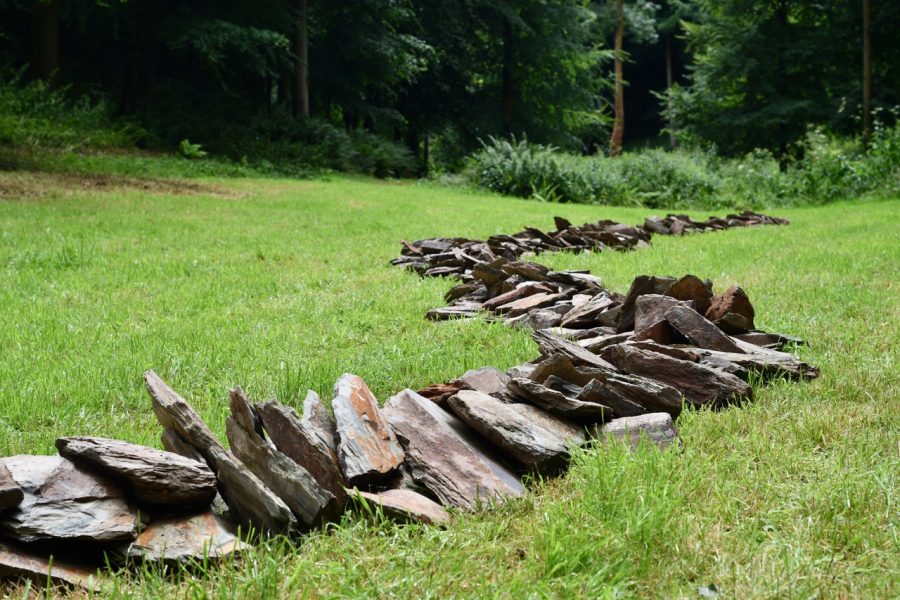
Richard Long’s newly installed sculptural artwork Jackdaw Line is set in Hestercombe’s Georgian Landscape Garden. Made using local Morte Slate it snakes through the landscape below the Box Pond at Hestercombe, and uses stone sourced from a quarry in the same valley.
Richard Long describes his work in general as a ‘love and celebration of the natural world’; of this new sculpture he says ‘I’m an opportunist, I was invited to make a work, not far from my home, in these beautiful gardens with a fantastic supply of stones, and the help of gardeners who turned their skilled hands to manning wheelbarrows.’ The meandering sculpture is a reminder for the artist of River of Stones, a work made at the eighteenth century Madhavendra Palace in Jaipur in 2018.
‘Work-shop’
by Lucy Soni
Fabric bunting
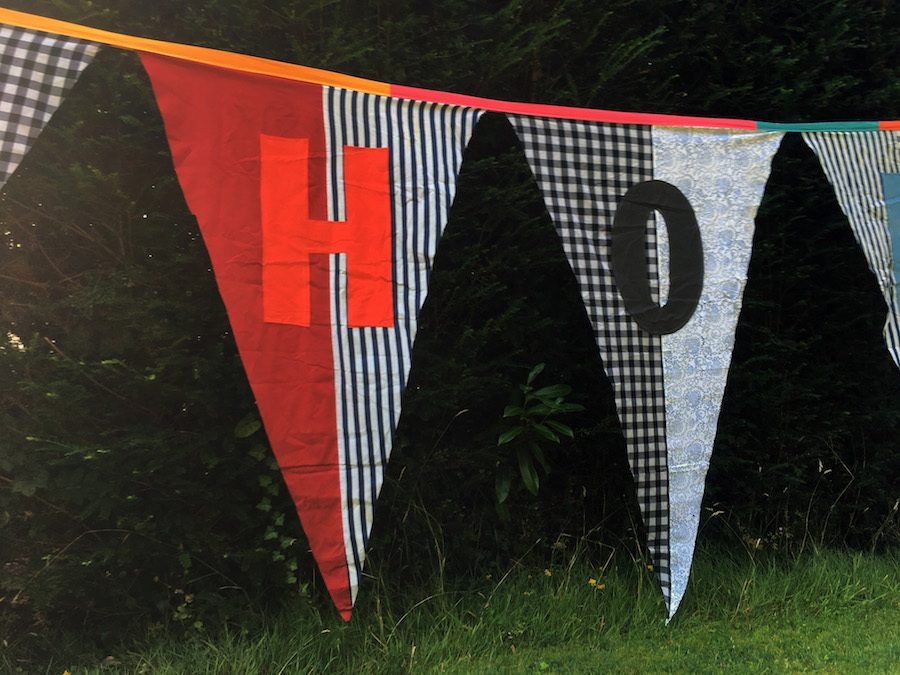
‘Whilst making my giant bunting piece ‘WORK-SHOP’ in 2019, I was musing on the feeling of being in an endless loop of working & shopping. It didn’t occur to me for a moment that a year later there would be a lockdown due to a global pandemic – a suspension of activity which would radically change the chance to do either of those things.
Now, with the easing of lockdown, the encouragement to work and shopping has returned, as if it is a moral duty to the economy of the country. As we tentatively step back outside, the economic landscape has dramatically changed, but the birds are still singing and the plants growing. Considering the bunting with this backdrop, perhaps the spaces between the letters are as pertinent as the cloth – making space for the greener landscape between and beyond the words is fundamental.’
Lucy Soni is interested in revaluing the everyday, what gets overlooked, forgotten, thrown away, wasted. Things we don’t think we need or want.
Many of her paintings start with a scribble made by one of her daughters when they were toddlers. For a year she put a new piece of raw canvas on her kitchen table each month; these now comprise a series of twelve paintings which evidence the comings and goings of her household. More recently, she has been interested in how paintings can become things that perform: by becoming like other things (tassels, bunting, paper chains, curtains) and acting in relation to space or place (draped over a wardrobe, decorating an entrance, coming out in a performance by Monster Chetwynd at Koko, London).
Soni’s works are unapologetically oversized. They are playful, oppressive, cloying, dancing, tactile. They make reference to stuff: domestic bliss, domestic overload, keeping a hold, letting go, getting lost, arriving for a moment, disappearing, appearing, blowing in, blowing out. They are absurd, overwhelmed, controlling, chaotic, responding, senseless, failing, making, playing. They ask questions but have no answers.
Bane
by Sarah Bennett
Copper
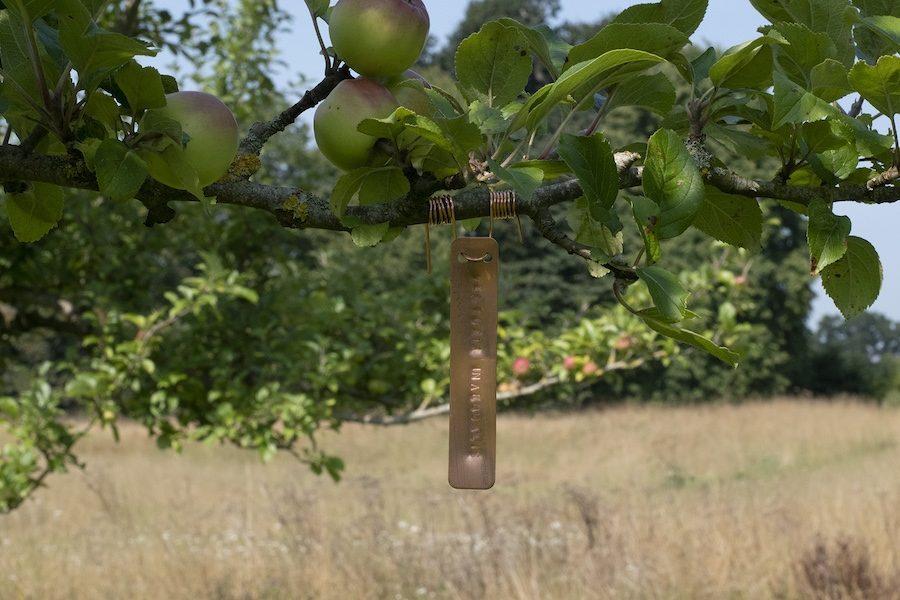
The plethora of plant pathogens and pests currently ravaging manifold plant species, calls for vigilance and expertise – and particularly for those who know the importance of maintaining healthy ecosystems; who value biodiversity and utilise bio-controls; and who observe bio-security. In Hestercombe’s museal gardens, it is the older cultivars that are highly susceptible to frequent bouts of commonplace plant and tree diseases, as well as those newly arrived imported strains. A conversation regarding the challenges facing Hestercombe’s Head Gardener, Claire Greenslade, became the catalyst for this project – Bane.
Bane comprises pathogenic designations – be they fungal, bacterial, viral or parasitic, that are prevalent at Hestercombe – punched onto copper plant tags and placed throughout the three historic gardens. Copper’s significance lies in its health-giving potential – known as a cure since ancient times. Through recent research, increased understanding of its antimicrobial properties and applications has developed, with copper infused fabrics, and copper alloys being used in medical settings. The next phase of the project – copper point drawings (Cuprum) – will evolve from this departure point.
In her art practice Bennett frequently engages an historical lens – habitually relating to institutional or dominant systems and codes – in order to flip the lens back towards contemporary contexts, to cast light on things that matter now. She uses a range of material processes and artistic research methods including: delving in archival resources, facsimile object making, observational drawing, embodied actions and digital recording, with artworks more often than not installed in non-gallery settings. Her published writings make connections between art and ecology, cultural geography, architecture, museology and psychiatry. As an academic she is involved in higher arts education across Europe and in the USA.
Stack
by Philippa Lawrence
Forestry tree-marker spray paints

Throughout 2016-18 Philippa Lawrence studied tree stumps, stacks of logs and cut wood in Hestercombe’s grounds, making two site responsive works Shift & Stasis, transforming fire-wood and stumps through the process of French polishing. Situated in the house as part of the exhibition: Materiality: Provisional States, 2018-19 these works referenced the value and status of materials and the earth’s resources.
Stack, 2020, located near the site of the Turkish Tent in the landscape garden, draws attention to labour and care within the grounds of Hestercombe. The coloured ends of this stack of logs are made using forestry tree-marker spray. They draw attention to activities, language and devices used in land management. The invitation to create work for this exhibition is an Opening-Up, affording the artist a chance to be experimental and freer in her practice.
Philippa Lawrence makes works that ask us to perceive things we may have overlooked or not considered, tracing humankind’s activity in managing an estate and nature. She has exhibited widely both in the UK and internationally, including America, Japan, Czech Republic, Canada, Iceland and Australia.
Graft ladder
by Jo Lathwood
Construction timber and apple wood veneer
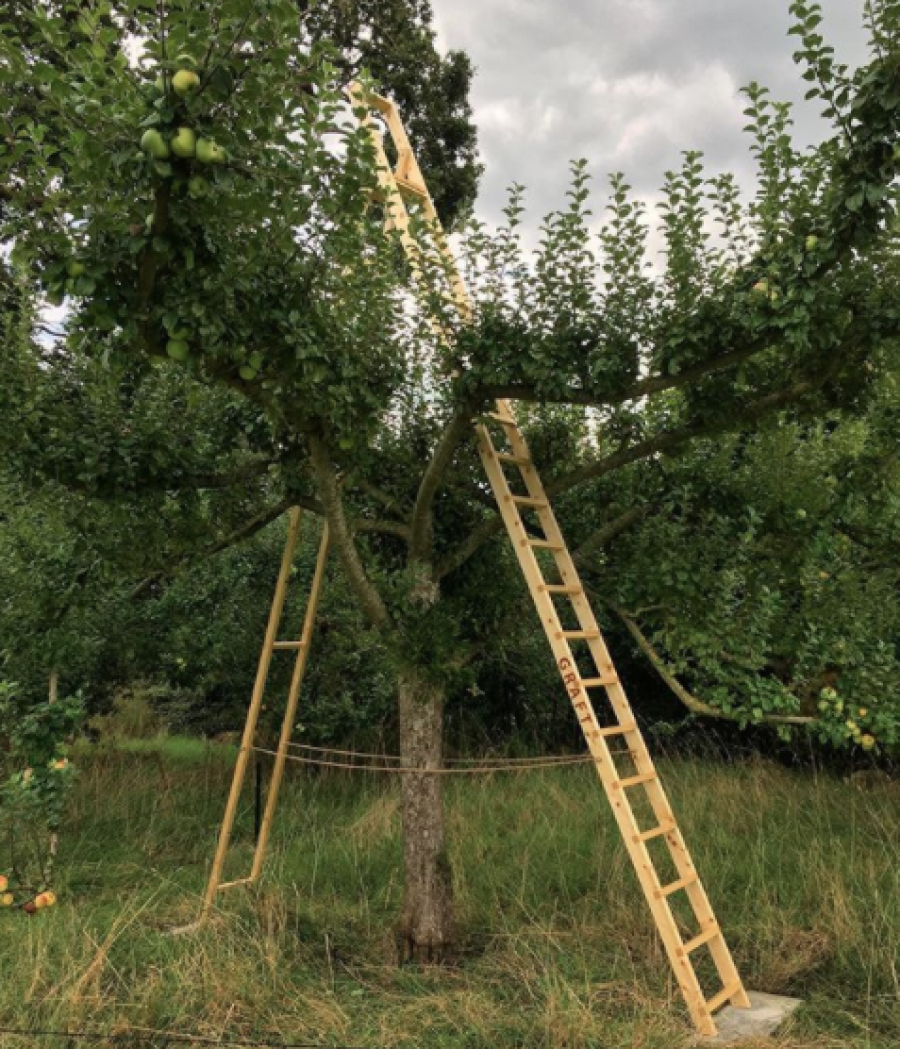
In the corner of Hestercombe’s apple and walnut orchard is a ladder straddling an unassuming tree. This ladder is different to the functional ones used regularly by the gardeners who tend the landscape; it stands as a monument to this time, a documentation of 2020. Like many fruit trees, apple trees need to be grafted to ensure the desired crop is obtained. Strangely, to plant a seed from a favourite variety does not ensure a tree will grow to bear that particular fruit.
‘Grafting’ from its primal definition is to join one part of a tree or plant to another so that they become one. This ancient technique attributed to the Persians and developed by the Romans involves diagonal cutting and banding together of two (or more) varieties ensuring the cambium layers marry up. After a time the two sections merge and form one tree, leaving behind a slowly disappearing scar at the base of the trunk. In British culture ‘to graft’ is a colloquialism referencing hard work often suggestive of manual labour.
Ladders of different forms have regularly made an appearance in Lathwood’s practice as she sees them as a symbol of change, desire and aspiration. During the Covid-19 lockdown, Lathwood spent time creating a series of intricate paintings representing imaginary and realistic ladders. These ladders represent the quintessential tools to get over something, to conquer obstacles and shift a viewpoint – a suitable mantra for this point in history. Graft ladder consolidates these ideas.
Lathwood was the first resident artist at Hestercombe in 2014-15. She makes sculptures and large scale installations which regularly respond to a particular site, event, material or process. Recurring themes within her practice are transitions, journeys, viewpoints, and illusion. Her portfolio varies greatly in form, scale, context and method of production, encompassing: temporary and permanent public art, exhibitions curated for galleries and heritage sites (often as the outcome of an artist residency) and studio-based work.
The Last Nail – Lancaster Cockpit
by Jon England
Approximately 18,000 galvanised nails and roofing felt
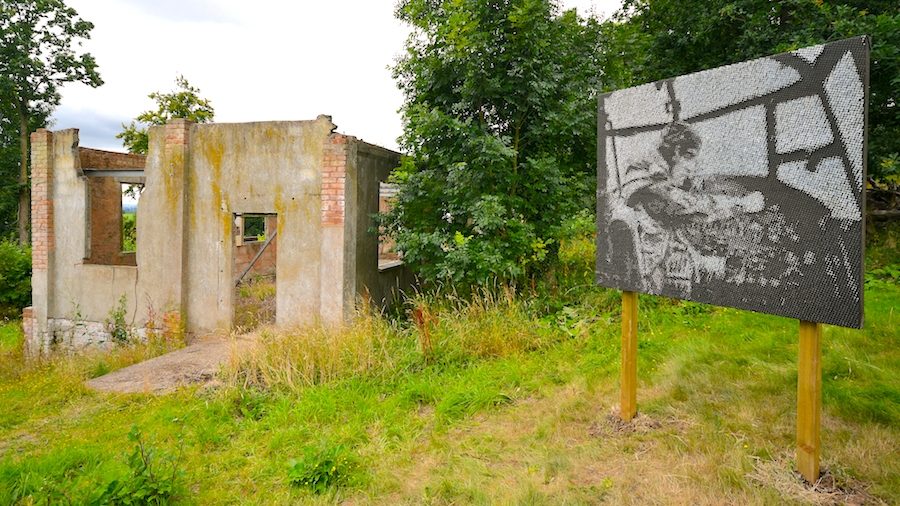
If each of the 18,000 nails in this work – symbols of human endeavour as well as crucifixion – were to represent a life lost, they would stand for less than a third of the 57,205 fatalities suffered by RAF Bomber Command during World War Two. Among the tens of thousands of civilians and personnel of all nations, who also suffered the catastrophe of aerial warfare, Leutnant Friedrich Kerkoff was pilot of a German Junkers JU88 that fell to earth close to Hestercombe on the night of 27th March 1944.
Both the stabilised remains of Hestercombe’s last surviving barrack block and The Last Nail, act as portals to a time that only a few can ‘remember’. An outsider looking in, England contemplates the suffocating confinement of the Lancaster’s cockpit and the fearful abyss beyond. Whether an act of devotion, penance, or commemoration, the repetitive grind of hammering can only hint at the brutality of the many cataclysms that define this period.
Created in the course of a long-term investigation of the experience of Prisoners of War, the piece’s bitumen and galvanised roofing nails refer to the architecture of incarceration. This utilitarian construction was echoed in the ‘maycrete’, asbestos or corrugated tin of Hestercombe’s forty barrack blocks – variously employed in the logistics of preparations against – and later for – invasion.
Jon England was born and works in Somerset. His work is concerned with the legacies of conflict and industry inscribed within landscape, object and individual as well as relationships between conflict and the natural world. His work has been commissioned by organisations including the Museum of Somerset and Fleet Air Arm Museum as well as being presented in Russia, Poland, and the USA.
Salt-cat (keeps them at home)
by Megan Calver and Gabrielle Hoad
Found text and objects, bird rings

Salt-cat was a type of cake made by pigeon breeders to entice their birds to stay or return home. Its ingredients included gravel, lime, saltpetre and stale urine. Drawing on Hestercombe’s archive, as well as sources such as The Sportsman’s Dictionary of 1800, Hoad and Calver have brought together a small flock of text fragments that relate to this practice. These phrases now nestle, together yet separate, in Perspex pigeonholes found in the vestibule that leads from the terrace garden into the house. Whilst referencing Hestercombe’s 19th century dovecote (now part of the visitor reception office), the work reflects on our new attachment to home brought about by the Covid-19 pandemic.
When installing the work we decided not to disturb the current inhabitants of the space (past and present) – leaving in place their dust, debris, webs, cocoons, moults, droppings and other remains – incorporating them instead into our work. This ‘dirt’ seemed especially affecting at a time when there’s so much focus on hygiene and cleanliness.
‘We were particularly conscious of a recently vacated swallow’s nest in the vestibule – the parents and fledglings now flying free overheard, preparing for migration, while our ringed, captive sticks remain wedged in their Perspex boxes, perhaps reaching out to each other, but certainly confined, numbered and filed away.’
Frequent collaborators since 2015, Megan Calver and Gabrielle Hoad share an interest in generating site-responsive work through oblique approaches to field study. Undertaking investigation of places and their inhabitants in a spirit of imaginative rather than empirical discovery, their approach often draws on the input of human and nonhuman participants.
Notes for editors
Hestercombe Gallery
Hestercombe Gallery opened in 2014 with the aim of showcasing the best in contemporary arts practice. Five years on from its opening Hestercombe Gallery has delivered a programme of high quality exhibitions in eight reclaimed spaces, a series of artists in residence, outdoor commissions as well as an engagement programme including talks, seminars and workshops involving artists, students, academics, teachers and experts from other disciplines.
Exhibitions have included Leaping the Fence; and Terrain: Land into Art featuring artists such as Tracey Emin, Marc Quinn, Peter Doig and Richard Long in partnership with Arts Council Collections. Solo shows by Tania Kovats, Clare Woods, Helen Sear and Tim Knowles. Group shows have included photographs by garden designer Gertrude Jekyll alongside photographers Sarah Jones, Helen Sear and Mark Edwards as well as showcasing historic works by painter and poet Rev. John Eagles together with contemporary work by Rebecca Chesney, Paul Desborough and Jem Southam.
Hestercombe has engaged with writers Lizzie Lloyd, Sarah Kent, Cherry Smyth and Phil Owen; delivered garden commissions by Jennie Savage and Gilles Bruni; and opened a second exhibition space for community and educational projects.
Hestercombe Estate
The Hestercombe estate in Somerset is a unique combination of three gardens that cover three centuries of garden history and design:
- the famous Edwardian formal garden, designed by architect Sir Edwin Lutyens and planted by Gertrude Jekyll;
- the Victorian Shrubbery and Terrace originally laid out by the 1st Viscount Portman in 1878;
- the eighteenth century landscape garden designed by Coplestone Warre Bampfylde between 1750 and 1791.
Hestercombe Gardens is managed by the Hestercombe Gardens Trust, established in 1996 as an independent charity. The Trust oversees the restoration and development of the gardens, house and archives to protect them for the future for public benefit.
Attracting over 100,000 visitors a year it is now 25 years since founder, Philip White MBE discovered the historic gardens and made it his life’s work to restore Hestercombe.
Hestercombe House, which was previously the headquarters for the Somerset Fire Brigade, was acquired by Hestercombe Gardens Trust in 2013, with Hestercombe Gallery opening in 2014.
